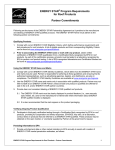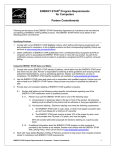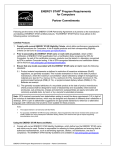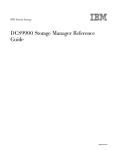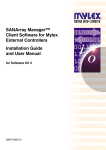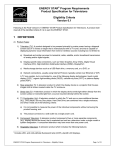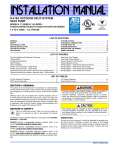Download ENERGY STAR Program Requirements for Computer Servers
Transcript
ENERGY STAR® Program Requirements for Computer Servers Partner Commitments Following are the terms of the ENERGY STAR Partnership Agreement as it pertains to the manufacture and labeling of ENERGY STAR qualified products. The ENERGY STAR Partner must adhere to the following partner commitments: Qualifying Products 1. Comply with current ENERGY STAR Eligibility Criteria, which define performance requirements and test procedures for Computer Servers. A list of eligible products and their corresponding Eligibility Criteria can be found at www.energystar.gov/specifications. 2. Prior to associating the ENERGY STAR name or mark with any product, obtain written certification of ENERGY STAR qualification from a Certification Body recognized by EPA for Computer Servers. As part of this certification process, products must be tested in a laboratory recognized by EPA to perform Computer Server testing. A list of EPA-recognized laboratories and certification bodies can be found at www.energystar.gov/testingandverification. Using the ENERGY STAR Name and Marks 3. Comply with current ENERGY STAR Identity Guidelines, which define how the ENERGY STAR name and marks may be used. Partner is responsible for adhering to these guidelines and ensuring that its authorized representatives, such as advertising agencies, dealers, and distributors, are also in compliance. The ENERGY STAR Identity Guidelines are available at www.energystar.gov/logouse. 4. Use the ENERGY STAR name and marks only in association with qualified products. Partner may not refer to itself as an ENERGY STAR Partner unless at least one product is qualified and offered for sale in the U.S and/or ENERGY STAR partner countries. 5. Provide clear and consistent labeling of ENERGY STAR qualified Computer Server families and configuration. 5.1. Partners must use the ENERGY STAR mark in all the following ways: 5.1.1. On the Computer Server manufacturer’s Internet site specification sheet where product information is displayed and configurations are provided: 1) This ENERGY STAR mark will also serve as a link from the manufacturer’s specification sheet to the corresponding Power and Performance Data Sheet for the qualified configuration or Product Family. 5.1.2. On the ENERGY STAR Power and Performance Data Sheet; and 5.1.3. The ENERGY STAR mark shall be used to identify qualified Product Families and/or configurations in collateral materials, which could include, but not be limited to: user manuals, product guides, marketing brochures, etc. 5.2. If additional information about the ENERGY STAR program or other products is provided by the Partner on its website, Partner must comply with the ENERGY STAR Web Linking Policy, which can be found at www.energystar.gov/partners. ENERGY STAR Program Requirements for Computer Servers– Partner Commitments 1 Verifying Ongoing Product Qualification 6. Participate in third-party verification testing through a Certification Body recognized by EPA for Computer Servers, providing full cooperation and timely responses, EPA/DOE may also, at its discretion, conduct tests on products that are referred to as ENERGY STAR qualified. These products may be obtained on the open market, or voluntarily supplied by Partner at the government’s request. Providing Information to EPA 7. Provide unit shipment data or other market indicators to EPA annually to assist with creation of ENERGY STAR market penetration estimates, as follows: 7.1. Partner must submit the total number of ENERGY STAR qualified Computer Servers shipped in the calendar year or an equivalent measurement as agreed to in advance by EPA and Partner. Partner shall exclude shipments to organizations that rebrand and resell the shipments (unaffiliated private labelers). 7.2. Partner must provide unit shipment data segmented by meaningful product characteristics (e.g., type, capacity, presence of additional functions) as prescribed by EPA. 7.3. Partner must submit unit shipment data for each calendar year to EPA or an EPA-authorized third party, preferably in electronic format, no later than March 1 of the following year. Submitted unit shipment data will be used by EPA only for program evaluation purposes and will be closely controlled. If requested under the Freedom of Information Act (FOIA), EPA will argue that the data is exempt. Any information used will be masked by EPA so as to protect the confidentiality of the Partner; 8. Report to EPA any attempts by recognized laboratories or Certification Bodies (CBs) to influence testing or certification results or to engage in discriminatory practices. 9. Notify EPA of a change in the designated responsible party or contacts within 30 days using the My ENERGY STAR Account tool (MESA) available at www.energystar.gov/mesa. Performance for Special Distinction In order to receive additional recognition and/or support from EPA for its efforts within the Partnership, the ENERGY STAR Partner may consider the following voluntary measures, and should keep EPA informed on the progress of these efforts: Provide quarterly, written updates to EPA as to the efforts undertaken by Partner to increase availability of ENERGY STAR qualified products, and to promote awareness of ENERGY STAR and its message. Consider energy efficiency improvements in company facilities and pursue benchmarking buildings through the ENERGY STAR Buildings program. Purchase ENERGY STAR qualified products. Revise the company purchasing or procurement specifications to include ENERGY STAR. Provide procurement officials’ contact information to EPA for periodic updates and coordination. Circulate general ENERGY STAR qualified product information to employees for use when purchasing products for their homes. Feature the ENERGY STAR mark(s) on Partner website and other promotional materials. If information concerning ENERGY STAR is provided on the Partner website as specified by the ENERGY STAR Web Linking Policy (available in the Partner Resources section of the ENERGY STAR website), EPA may provide links where appropriate to the Partner website. Ensure the power management feature is enabled on all ENERGY STAR qualified displays and computers in use in company facilities, particularly upon installation and after service is performed. Provide general information about the ENERGY STAR program to employees whose jobs are relevant to the development, marketing, sales, and service of current ENERGY STAR qualified products. ENERGY STAR Program Requirements for Computer Servers– Partner Commitments 2 Provide a simple plan to EPA outlining specific measures Partner plans to undertake beyond the program requirements listed above. By doing so, EPA may be able to coordinate, and communicate Partner’s activities, provide an EPA representative, or include news about the event in the ENERGY STAR newsletter, on the ENERGY STAR website, etc. The plan may be as simple as providing a list of planned activities or milestones of which Partner would like EPA to be aware. For example, activities may include: (1) increasing the availability of ENERGY STAR qualified products by converting the entire product line within two years to meet ENERGY STAR guidelines; (2) demonstrating the economic and environmental benefits of energy efficiency through special in-store displays twice a year; (3) providing information to users (via the website and user’s manual) about energy-saving features and operating characteristics of ENERGY STAR qualified products; and (4) building awareness of the ENERGY STAR Partnership and brand identity by collaborating with EPA on one print advertorial and one live press event. Join EPA's SmartWay Transport Partnership to improve the environmental performance of the company's shipping operations. The SmartWay Transport Partnership works with freight carriers, shippers, and other stakeholders in the goods movement industry to reduce fuel consumption, greenhouse gases, and air pollution. For more information on SmartWay, visit www.epa.gov/smartway. Join EPA’s Green Power Partnership. EPA's Green Power Partnership encourages organizations to buy green power as a way to reduce the environmental impacts associated with traditional fossil fuelbased electricity use. The partnership includes a diverse set of organizations including Fortune 500 companies, small and medium businesses, government institutions as well as a growing number of colleges and universities. For more information on Green Power, visit www.epa.gov/greenpower. ENERGY STAR Program Requirements for Computer Servers– Partner Commitments 3 ENERGY STAR® Program Requirements Product Specification for Computer Servers Eligibility Criteria Version 1.1 Following is the Version 1.1 ENERGY STAR Product Specification for Computer Servers. A product shall meet all of the identified criteria if it is to earn the ENERGY STAR. 1 DEFINITIONS A) Product Types: 1) Computer Server: A computer that provides services and manages networked resources for other computers or networked devices. Computer servers are sold through enterprise channels for use in data centers and office/corporate environments. A computer server is designed to be primarily accessed via network connections, and not through direct user input devices such as a keyboard, mouse, etc. In addition, a computer server has all of the following characteristics: a) Marketed and sold as a computer server; b) Designed for and listed as supporting computer server operating systems (OS) and/or hypervisors, and targeted to run user-installed enterprise applications; c) Support for error-correcting code (ECC) and/or buffered memory (including both buffered DIMMs and buffered on board (BOB) configurations); d) Packaged and sold with one or more ac-dc or dc-dc power supplies; and e) All processors have access to shared system memory and are independently visible to a single OS or hypervisor. 2) Blade System: A system comprised of a blade chassis and one or more removable blade servers and/or other units (e.g., blade storage, blade network equipment). A blade system provides a scalable means for combining multiple blade server or storage units in a single enclosure, and is designed to allow service technicians to easily add or replace (hot-swap) blades in the field. a) Blade Server: A computer server that is designed for use in a blade chassis. A blade server is a high-density device that includes at least one processor and system memory but is dependent upon shared blade chassis resources (e.g., power supplies, cooling) for operation. b) Blade Chassis: An enclosure containing shared resources for the operation of blade server, blade storage, and other blade form factor units. Shared resources provided by a blade chassis may include power supplies, shared data storage, and hardware for dc power distribution, thermal management, system management, and network services. c) Blade Storage: A storage device that is designed for use in a blade chassis. A blade storage device is dependent upon shared blade chassis resources (e.g., power supplies, cooling) for operation. 3) Direct Current (Dc) Server: A computer server with one or more dc-dc power supplies that runs directly off dc power. ENERGY STAR Program Requirements for Computer Servers – Eligibility Criteria Page 1 of 15 4) Fully Fault Tolerant Server: A computer server designed with complete redundancy, in which every computing component is replicated between two nodes running identical and concurrent workloads. If one node fails or needs repair, the second node can run the workload alone to avoid any downtime. A fully fault tolerant server uses two systems to simultaneously and repetitively run a single workload for continuous availability in a mission critical application. 5) Managed Server: A computer server designed for a high level of availability in a highly-managed environment. A managed server has all of the following characteristics: a) Capable of operation with redundant power supplies; and b) An installed dedicated management controller (e.g., service processor). 6) Dual-node Server: Two independent computer servers (or nodes) contained in a single enclosure and sharing one or more power supplies. The combined power for all nodes is distributed through the shared power supplies. A dual-node server is designed and built as a single enclosure and is not designed to be hot-swappable. 7) Multi-node Server: Greater than two independent computer servers (or nodes) contained in a single enclosure and sharing one or more power supplies. The combined power for all nodes is distributed through the shared power supplies. A multi-node server is designed and built as a single enclosure and is not designed to be hot-swappable. 8) Server Appliance: A self-contained computer server system bundled with a pre-installed OS and application software that is used to perform a dedicated function or set of tightly coupled functions. Server Appliances deliver services through one or more networks (e.g, IP or SAN), and are typically managed through a web or command line interface. Server Appliance hardware and software configurations are customized by the vendor to perform a specific task, and are not intended to execute user-supplied software. Example services that may be made available via a Server Appliance include: name services, firewall services, authentication services, encryption services, and voice-over-IP (VoIP) services. B) Other Data Center Equipment 1) Network Equipment: A product whose primary function is to provide data connectivity among devices connected to its several ports. Data connectivity is achieved via the routing of data packets encapsulated according to Internet Protocol, Fibre Channel, InfiniBand or similar protocol. Examples of network equipment commonly found in data centers are routers and switches. 2) Storage Equipment: A system composed of integrated storage controllers, storage devices (e.g., hard drives or solid state storage) and software that provides data storage services to one or more computer servers. While storage equipment may contain one or more embedded processors, these processors do not execute user-supplied software applications but may execute data-specific applications (e.g., data replication, backup utilities, data compression, install agents, etc.). C) Computer Server Components 1) Computer Server Power Supply Unit (PSU): A self-contained component that converts a voltage input to one or more dc voltage outputs for the purpose of powering the computer server. The input voltage may be from an ac source or a dc source. A computer server PSU is separable from the main computer board and connects to the system via a removable or hard-wired male/female electrical connection, cable, cord or other wiring (i.e. separate from, and not integrated with, the system motherboard). This definition includes the following sub-types: ENERGY STAR Program Requirements for Computer Servers – Eligibility Criteria Page 2 of 15 a) Ac-Dc Power Supply: A PSU that converts line voltage ac input power into one or more different dc outputs. b) Dc-Dc Power Supply: A PSU that converts a dc voltage input to one or more different dc voltage outputs. This definition excludes internal dc-to-dc converters (also known as voltage regulators) that are used to convert low voltage dc (e.g. 12 Volts dc) into other dc voltages for use by computer server components. c) Single-Output Power Supply: A PSU that delivers most of its rated power through one primary dc output. Single-output PSUs may include one or more standby outputs which remain active whenever connected to an input power source. There may be additional outputs besides the primary output and standby outputs, however, the combined power from all additional outputs is less than or equal to 20 watts. PSUs with multiple outputs at the primary voltage are considered single-output PSUs, unless these outputs: (1) are generated from separate converters or have separate output rectification stages, and/or (2) have independent current limits. d) Multi-Output Power Supply: A PSU that delivers its power through more than one primary output, including one or more standby outputs which remain active whenever connected to an input power source. For multi-output PSUs, the combined power from additional outputs other than the primary and standby outputs is greater than 20 watts. This definition also applies to power supplies with multiple outputs at the same voltage that do not meet the definition of a single-output PSU. 2) I/O Device: A device that provides data input and output capability to the computer server from other devices. An I/O device may be integral to the main computer board or may be a separate device connected though expansion slots such as PCI or PCIe. Examples of I/O devices include: a) Ethernet devices; b) InfiniBand devices; c) External RAID/SAS controllers; and d) Fibre Channel devices. 3) I/O Port: Physical circuitry within an I/O device where an independent I/O session can be established. A port is not the same as a connector receptacle, since a single receptacle/connector may service multiple ports of the same interface. D) Operational Modes 1) Idle State: An operational state in which the operating system and other software have completed loading and the computer server is capable of completing workload transactions, but no active workload transactions are requested or pending by the system (i.e., the Computer Server is operational, but not processing any useful work). ENERGY STAR Program Requirements for Computer Servers – Eligibility Criteria Page 3 of 15 E) Product Family: A group of product models that are (1) made by the same manufacturer, (2) subject to the same ENERGY STAR qualification criteria, and (3) of a common basic design. For Computer Servers, product families consist of product models that satisfy the following criteria: 1) Are from a single model line; 2) Include the same model motherboard; 3) Include processors per the following guidelines: a) Incorporate processors from a single model line, with identical power specifications (e.g., Thermal Design Power) and core count; b) Incorporate the same quantity of installed discrete processor packages (e.g., a branded processor, not a number of cores); c) Processor clock speed may vary within a product family. 4) Include power supplies per the following guidelines: a) Incorporate power supplies from a single model line, with identical technical and power specifications (e.g., maximum rated output power); b) The number of power supplies may vary within a product family. 5) Include memory (DIMMs) per the following guidelines: a) Incorporate memory modules of a single type (e.g., DIMM, FB-DIMM) and technical specifications; b) The number and capacity of memory modules may vary within a product family. 6) Include hard drives per the following guidelines: a) Incorporate hard drives of a single type (e.g., Hard Disk Drives (HDD) or Solid State Drives (SSD)), and technical specifications (e.g., spindle speed, interface (e.g., SCSI); b) The number and capacity of hard drives may vary within a product family; c) A configuration without an internal hard drive, but otherwise identical to the Minimum Configuration, may be included in a product family. ENERGY STAR Program Requirements for Computer Servers – Eligibility Criteria Page 4 of 15 7) Include I/O devices per the following guidelines: a) Incorporate I/O devices with identical technical and power specifications. b) Multiple types of I/O devices may be included in a product family. c) A configuration without an add-in I/O device may be included in a product family, with any number of add-in I/O devices included in other configurations. F) Product Configurations: 1) Maximum Configuration: A highly configured product that includes the combination of power supplies, memory, hard drives, I/O devices, etc. that results in the maximum possible power consumption within a product family. 2) Minimum Configuration: A minimally configured product that includes at least one hard drive and is currently available and sold in the marketplace (i.e., not under-configured). The Minimum Configuration typically has the minimum quantity of power supplies, minimum quantity of memory modules, a single hard drive, and a single integrated or add-in I/O device. 3) Typical Configuration: An intermediate configuration between the Maximum Configuration and Minimum Configuration. The Typical Configuration is representative of a product with high-volume sales. 4) Base Configuration: A reference configuration that does not qualify for any additional power allowances. The Base Configuration includes: a) One hard disk drive or solid state drive; b) 4 Gigabytes (GB) of system memory; c) The minimum number of power supplies required to operate the Computer Server (i.e., no redundant power supplies); and d) Two ports of 1 Gigabit per second (Gbit/s) onboard Ethernet. 2 SCOPE 2.1 2.1.1 2.2 2.2.1 Included Products Products that meet both of the following conditions are eligible for ENERGY STAR qualification, with the exception of products listed in Section 2.2: i. Meet the definition of a Computer Server; and ii. Host 1 to 4 individual processor sockets. Excluded Products Products that are covered under other ENERGY STAR product specifications are not eligible for qualification under this specification. The list of specifications currently in effect can be found at www.energystar.gov/products. ENERGY STAR Program Requirements for Computer Servers – Eligibility Criteria Page 5 of 15 2.2.2 The following products are not eligible for qualification under this specification: i. Blade Systems including Blade Servers and Blade Chassis; ii. Fully Fault Tolerant Servers; iii. Server Appliances; iv. Multi-Node Servers; v. Storage Equipment, including Blade Storage; and vi. Network Equipment. 3 QUALIFICATION CRITERIA 3.1 Significant Digits and Rounding 3.1.1 All calculations shall be carried out with actual measured or observed values. Only the final result of a calculation shall be rounded. Calculated results shall be rounded to the nearest significant digit as expressed in the corresponding specification limit. 3.1.2 Unless otherwise specified, compliance with specification limits shall be evaluated using exact values without any benefit from further rounding. 3.2 Power Supply (PSU) Requirements 3.2.1 Power supply test data and test reports from manufacturer-independent test entities accredited to perform power supply testing and approved by EPA shall be recognized for the purpose of qualifying the ENERGY STAR product. 3.2.2 Efficiency: Computer Server PSUs shall meet efficiency requirements as specified in Table 1 when tested using the EPRI Generalized Internal Power Supply Efficiency Test Protocol, Rev. 6.4.2 (available at www.efficientpowersupplies.org). Table 1: Power Supply Efficiency Requirements 3.2.3 Multi-Output (Ac-Dc & Dc-Dc) Load Level as a Percentage of Nameplate Output Current All Output Levels ≤ 500 watts > 500 to 1000 watts > 1000 watts 10% 20% 50% 100% N/A 0.82 0.85 0.82 0.70 0.82 0.89 0.85 0.75 0.85 0.89 0.85 0.80 0.88 0.92 0.88 Single-Output (Ac-Dc & Dc-Dc) Power Factor: Computer Server ac-dc PSUs shall meet power factor requirements as specified in Table 2 when tested using the EPRI Generalized Internal Power Supply Efficiency Test Protocol, Rev. 6.4.2 (available at www.efficientpowersupplies.org). ENERGY STAR Program Requirements for Computer Servers – Eligibility Criteria Page 6 of 15 Table 2: Power Factor Requirements for Ac-Dc Power Supplies Load Level as a Percentage of Nameplate Output 1 Current Single-Output Multi-Output ≤ 500 watts > 500 to 1000 watts > 1000 watts 10% N/A N/A 0.65 0.80 20% 0.80 0.80 0.80 0.90 50% 0.90 0.90 0.90 0.90 100% 0.95 0.95 0.95 0.95 3.3 Power Management Requirements 3.3.1 Three-socket (3S) and four-socket (4S) servers shall be configured with processor-level power management to reduce power consumption of the processor during periods of low utilization. Power management for three- and four-socket servers shall be implemented as follows: i. Power management functionality shall be enabled in the system BIOS, and/or a management controller or service processor. ii. For systems that ship with a pre-installed supervisor system (OS or hypervisor), power management functionality shall be enabled by default in the supervisor system. iii. All processors shall be capable of reducing power consumption in times of low utilization, by either (1) reducing voltage and/or frequency through Dynamic Voltage and Frequency Scaling (DVFS), or (2) using processor or core reduced power states when a core or socket is not being used. iv. Power management techniques that are enabled by default shall be reported on the Power and Performance Data Sheet, per the requirements in Section 3.5 of this specification. 3.3.2 Dual-node servers with three or four sockets per node shall meet the processor power management requirements specified for 3S and 4S servers. 3.3.3 One-socket (1S) and two-socket (2S) servers may be configured with processor level power management to reduce power use of the processor during times of low utilization. 3.4 Idle State and Full Load Power Requirements 3.4.1 1S and 2S Servers: Measured Idle State power (PIDLE) shall be less than or equal to the Maximum Idle State Power Requirement (PIDLE_MAX), as calculated per Equation 1. 1 The power factor requirements in Table 2 must be met in all loading conditions where the output power is greater than or equal to 75 watts. Measurement and reporting of power factor values for applicable loading conditions less than 75 watts is still required. ENERGY STAR Program Requirements for Computer Servers – Eligibility Criteria Page 7 of 15 Equation 1: Calculation of Maximum Idle State Power n PIDLE _ MAX = PBASE + ∑ PADDL _ i i =1 Where: PIDLE_MAX is the Maximum Idle State Power Requirement, PBASE is the base idle power allowance, as determined per Table 3 PADDL_i is the Idle State power allowance for additional components, as determined per Table 4 Table 3: Base Idle State Power Allowances for 1S and 2S Servers Category Number of Installed Processors (# P) Managed Server Base Idle State Power Allowance, PBASE (watts) A 1 No 55.0 B 1 Yes 65.0 C 2 No 100.0 D 2 Yes 150.0 Table 4: Additional Component Idle State Power Allowances for 1S and 2S Servers Installed Component Additional Power Supply Additional Hard Drive (HDD and SSD) Additional Memory (rounded to the nearest GB) Additional I/O Device (single connection speed rounded to nearest Gbit) Applies To PSUs installed explicitly ii for power redundancy Installed hard drives greater than one Idle State Power Allowance for Additional Components, PADDL_i (watts) 20.0 watts per Power Supply 8.0 watts per Hard Drive Installed memory greater than 4 GB 2.0 watts per GB Installed I/O devices greater than two ports of 1 Gbit, onboard iii,iv, v Ethernet < 1 Gbit: No Allowance = 1 Gbit: 2.0 watts / Active Port > 1 Gbit and < 10 Gbit: 4.0 watts / Active Port ≥ 10 Gbit: 8.0 watts / Active Port i. These Idle power limits are applicable to single and dual socket systems only, regardless of the number of processors (e.g., a three or four socket system with only one or two processors installed would not be subject to this requirements). ii. All quantities in Table 3 and Table 4 refer to the number of components installed in the system, not the maximum number of components the system can support (e.g., installed processors, not processor sockets; installed memory, not supported memory; etc.) iii. The Additional Power Supply allowance may be applied for each PSU in addition to the minimum quantity necessary to operate the Computer Server. ENERGY STAR Program Requirements for Computer Servers – Eligibility Criteria Page 8 of 15 3.4.2 3.4.3 3.5 iv. The Additional I/O Device allowance may be applied for all I/O Devices over the Base Configuration (i.e., Ethernet devices additional to two ports of 1 Gigabit per second (Gbit/s), onboard Ethernet, plus any non-Ethernet I/O devices), including on-board I/O devices and add-in I/O devices installed through expansion slots. v. The Additional I/O Device allowance shall be calculated based upon the rated link speed of a single connection, rounded to the nearest Gbit. I/O devices with less than 1 Gbit speed do not qualify for the Additional I/O Device allowance. vi. The Additional I/O Device allowance shall only be applied for I/O devices that are active/enabled upon shipment, and are capable of functioning when connected to an active switch. Dual-node Servers: For dual-node servers with one or two sockets per node, measured Idle State power on a per-node basis shall be less than or equal to the Maximum Idle State Power Requirement (PIDLE_MAX), as calculated per Equation 1. i. If both nodes in the system are identical in configuration and use identical components, Idle State power per node shall be calculated by measuring the Idle State power of the entire system (including both server nodes) and dividing by two. ii. Idle power for each node and the Full Idle power of the entire system (including both server nodes) shall be measured and reported on the Power and Performance Data Sheet per the requirements in Section 3.5 of this specification. 3S and 4S Servers: Idle State power requirements are not applicable to three-socket (3S) and four-socket (4S) computer servers. However, both Idle State and Full Load power for these products shall be measured per the ENERGY STAR Test Method and reported on the Power and Performance Data Sheet. Standard Information Reporting Requirements 3.5.1 A standardized Power and Performance Data Sheet (PPDS) shall be completed for each ENERGY STAR qualified Computer Server and posted with other product configuration information on the Partner’s website. Partners are encouraged to provide one data sheet per qualified configuration, but may also provide one data sheet per Product Family (as defined in Section 1) with data on the power and performance in Maximum, Minimum and Typical configurations. 3.5.2 If one PPDS is used to represent a Product Family, Partners are encouraged to provide a link to a more detailed power calculator where information on the power consumption of specific system configurations can be found. 3.5.3 Templates for the PPDS can be found on the ENERGY STAR Web page for Computer Servers at www.energystar.gov/products. Partners are encouraged to use the template provided by EPA, but may also create their own template provided that it has been approved by EPA and contains the following information, at a minimum: i. Model name and number, identifying SKU and/or configuration ID; ii. System characteristics (form factor, available sockets/slots, power specifications, etc.); iii. System configuration(s) (including maximum, minimum and typical configurations for product family qualification); ENERGY STAR Program Requirements for Computer Servers – Eligibility Criteria Page 9 of 15 iv. Power data for Idle State and Full Load, estimated energy consumption in kWh/year, link to power calculator (where available); v. Additional power and performance data for at least one benchmark chosen by the Partner; vi. Available and enabled power saving features (e.g., power management); vii. Information on the power measurement and reporting capabilities of the Computer Server; viii. Select thermal information from the ASHRAE thermal report; and ix. A list of additional qualified SKUs or configuration IDs, along with specific configuration information (for Product Family qualification only). 3.5.4 EPA may periodically revise this template, as necessary, and will notify Partners of the revision process. Partners should always use the most recent version of the data sheet posted to the ENERGY STAR Web site. 3.6 Data Measurement and Output Requirements 3.6.1 Data Elements: One-socket and two-socket (1S and 2S) Managed Servers and all Computer Servers with greater than two sockets (3S and 4S) shall be capable of measuring and reporting the following data elements: 3.6.2 3.6.3 i. Input Power, in watts, with recommended accuracy at the system level of ± 10%, with a cutoff of ± 10 watts (i.e., accuracy is not required to be better than ±10 W). ii. Inlet Air Temperature, in degrees Celsius, with accuracy of ± 3°C. iii. Estimated Processor Utilization, for each logical CPU that is visible to the OS. This data shall be reported to the operator or user of the computer server through the operating environment (OS or hypervisor). Reporting Implementation: i. Data shall be made available in a published or user-accessible format that is readable by third-party, non-proprietary management systems; ii. Data shall be made available to end users and third-party management systems over a standard network connection; iii. Data shall be made available via embedded components or add-in devices that are packaged with the Computer Server (e.g., a service processor, embedded power or thermal meter or other out-of-band technology, or pre-installed OS); iv. Products shipped with a pre-installed OS shall include all necessary drivers and software installed to make this information openly available. Products that do not include a preinstalled OS shall be packaged with printed documentation of methods to access registers that contain relevant sensor information; v. When an open and universally available data collection and reporting standard becomes available, manufacturers should incorporate the universal standard into their products. Sampling Requirements: Data shall be averaged on either a rolling basis or over a manufacturer specified time period. A default rolling average or time period of 30 seconds is recommended. ENERGY STAR Program Requirements for Computer Servers – Eligibility Criteria Page 10 of 15 3.6.4 Documentation Requirements: The following information shall be included on the Power and Performance Data Sheet: i. Guaranteed accuracy levels for power and temperature measurements, and ii. The time period used for data averaging. 3.7 Additional Requirements 3.7.1 Energy Efficient Ethernet: EPA plans to investigate the use of the Energy Efficient Ethernet (IEEE 802.3az) standard for all external physical layer Ethernet (e.g., 1 Gbit and 10 Gbit wired Ethernet) following its ultimate approval by IEEE. More information on the developing standard can be found at http://grouper.ieee.org/groups/802/3/az/. 4 TESTING 4.1 4.1.1 Test Methods When testing Computer Server products, the test methods identified in Table 5 shall be used to determine ENERGY STAR qualification. Table 5: Test Methods for ENERGY STAR Qualification Product Type All Products 4.2 4.2.1 Test Method ENERGY STAR Test Method for Computer Servers, Rev. Aug2010 (Idle Testing as outlined in Section 4.B for Idle power requirements of Single- and Dual-socket Computer Servers, and for Idle power and full load power reporting of all Computer Servers on the Power and Performance Data Sheet) Number of Units Required for Testing Representative Models shall be selected for testing per the following requirements: i. For qualification of an individual product model, a product configuration equivalent to that which is intended to be marketed and labeled as ENERGY STAR is considered the Representative Model; ii. For qualification of a product family, both the Maximum and Minimum Configurations that are intended to be marketed and labeled as ENERGY STAR are considered Representative Models. Both the Maximum and Minimum Configuration Representative Models shall be configured for testing with: • memory module(s) of the maximum available density (GB/module) and • hard drive(s) of the maximum available power draw. ENERGY STAR Program Requirements for Computer Servers – Eligibility Criteria Page 11 of 15 4.3 Input Power Guidelines 4.3.1 Products shall be tested for qualification at the input voltage/frequency combinations specified in the ENERGY STAR Test Method for Computer Servers. 4.3.2 Ac-powered products with multi-output PSUs shall be tested for qualification at all relevant input voltage/frequency combinations for each market in which the unit is capable of operation. 4.3.3 Products intended to be sold into Japan may optionally be tested at Japanese input voltage/frequency for Idle and Full Load testing. Testing shall also be conducted at the required voltage/frequency combinations in Sections 4.3.1 and 4.3.2. 4.4 4.4.1 Power Supply Testing PSUs shall be tested using the input test conditions specified in Table 6, and as specified in the ENERGY STAR Test Method for Computer Servers. i. Ac-dc multi-output PSUs capable of operating with both 230V and 115V input shall be tested at both input voltages. ii. Ac-dc multi-output PSUs capable of operating with only one of these indicated voltages shall be tested only at the applicable voltage. iii. Testing with 230V input may be conducted with input frequency of either 50Hz or 60Hz. Table 6: Input Conditions for Power Supply Efficiency Testing Power Supply Type Ac-Dc Single-output Ac-Dc Multi-output Dc-Dc Input Test Conditions 230 Volts, 50Hz or 60 Hz 115 Volts, 60 Hz and/or 230 Volts, 50Hz or 60Hz +53 Volts DC or -53 Volts DC iv. 10% Load Condition: Single-output PSUs shall be tested at 10% load conditions, in addition to the 20%, 50% and 100% load conditions specified in the ENERGY STAR Test Method for Computer Servers. v. Fan Power: Fan power may be excluded from measurements and/or efficiency calculations for single-output PSUs. Fan power shall be included in measurements and efficiency calculations for multi-output PSUs. vi. Efficiency and Power Factor Reporting: PSU efficiency test results shall be reported to the first decimal place (e.g. 85.2%). PSU power factor test results shall be reported to three decimal points (e.g., 0.816). 5 EFFECTIVE DATE 5.1.1 Effective Date: The Version 1.1 ENERGY STAR Computer Server specification shall take effect on the dates specified in Table 7. To qualify for ENERGY STAR, a product model shall meet the ENERGY STAR specification in effect on its date of manufacture. The date of manufacture is specific to each unit and is the date (e.g., month and year) on which a unit is considered to be completely assembled. ENERGY STAR Program Requirements for Computer Servers – Eligibility Criteria Page 12 of 15 5.1.2 Future Specification Revisions: EPA reserves the right to change this specification should technological and/or market changes affect its usefulness to consumers, industry, or the environment. In keeping with current policy, revisions to the specification are arrived at through stakeholder discussions. In the event of a specification revision, please note that the ENERGY STAR qualification is not automatically granted for the life of a product model. Table 7: Specification Effective Dates Effective Date May 15, 2009 ENERGY STAR Program Requirements for Computer Servers – Eligibility Criteria Page 13 of 15 APPENDIX A: Sample Calculations Idle State Power Requirements To determine Maximum Idle State Power Requirement for ENERGY STAR qualification, determine the base Idle level from Table 3, then add power allowances from Table 4. An example is provided below: EXAMPLE: A standard single processor Computer Server with 8 GB of memory, two hard drives, and two I/O devices (the first with two 1 Gbit ports and the second with six 1 Gbit ports). 1. Base allowance: a. Determine base idle allowance from Table 3. b. The example server is evaluated under Category A and could consume no more than 55.0 watts in Idle to qualify for ENERGY STAR. Category Number of Installed Processors (# P) Managed Server Base Idle Power Allowance (W) A 1 No 55.0 B 1 Yes 65.0 C 2 No 100.0 D 2 Yes 150.0 2. Additional Idle Power Allowances: Calculate additional idle allowances for extra components from Table 4. System Characteristic Additional Power Supplies Additional Hard Drives (including solid state drives) Additional Memory Additional I/O Devices (single connection speed rounded to nearest Gbit) Applies To Additional Idle Power Allowance Power supplies installed explicitly for power redundancy 20.0 watts per Power Supply Installed hard drives greater than one 8.0 watts per Hard Drive Installed memory greater than 4 GB 2.0 watts per GB Installed Devices greater than two ports of 1 Gbit, onboard Ethernet < 1 Gbit: No Allowance = 1 Gbit: 2.0 watts / Active Port > 1 Gbit and < 10 Gbit: 4.0 watts / Active Port ≥ 10 Gbit: 8.0 watts / Active Port a. The example server has one hard drive in excess of the base configuration. It therefore is provided with an additional 8.0 watt allowance for the hard drive (1 HDD x 8.0 watts). b. The example server has 4 GB in excess of the base configuration. It therefore is provided with an additional 8.0 watt allowance for memory (4 extra GB x 2.0 watts/GB). c. The example server has one I/O card that does not qualify for an adder: the first device has only two Ethernet ports and does not exceed the two-port threshold. Its second device does qualify for an adder: the server is provided with an additional 12.0 watt allowance for the device (6 Gbit ports x 2.0 watts/active port). ENERGY STAR Program Requirements for Computer Servers – Eligibility Criteria Page 14 of 15 3. Calculate the final Idle allowance by adding the base allowance with the additional power allowances. The example system would be expected to consume no more than 83.0 watts at Idle to qualify (55.0 W + 8.0 W + 8.0 W + 12.0 W). Additional Idle Allowance - Power Supplies The following examples illustrate the idle power allowances for additional power supplies: A. If a Computer Server requires two power supplies to operate, and the configuration includes three installed power supplies, the server would receive an additional 20.0 watt Idle power allowance. B. If the same server were instead shipped with four installed power supplies, it would receive an additional Idle power allowance of 40.0 watts. ENERGY STAR Program Requirements for Computer Servers – Eligibility Criteria Page 15 of 15 ENERGY STAR® Program Requirements Product Specification for Computer Servers Test Method 1 OVERVIEW The following test method shall be used for determining compliance with requirements in the ENERGY STAR Eligibility Criteria for Computer Servers, and when acquiring test data for reporting of Full Load power on the ENERGY STAR Power and Performance Data Sheet. 2 APPLICABILITY The following test method is applicable to all products eligible for qualification under the ENERGY STAR Eligibility Criteria for Computer Servers. 3 DEFINITIONS Unless otherwise specified, all terms used in this document are consistent with the definitions contained in the ENERGY STAR Eligibility Criteria for Computer Servers. 4 TEST SETUP A) Input Power: Input power shall be as specified in Table 1. ENERGY STAR Program Requirements for Computer Servers – Test Method (Rev. Aug-2010) Page 1 of 5 Table 1: Input Power Requirements for Computer Servers with Single-Output or Dc-Dc Power Supplies Product Type Supply Voltage Servers with Ac-Dc Single-Output PSUs 230 Vac Servers with Ac-Dc 1 Multi-Output PSUs 230 Vac and/or 115 Vac Optional Testing Conditions For AcDc Japanese Market2 100 Vac Dc Servers +/- 53 Vdc +/- 1.0 % (for products which are rated for ≤ 1.5 kW maximum Power) or Maximum Total Harmonic Distortion 2.0 % (for products which are rated for ≤ 1.5 kW maximum Power) or 4.0 % (for products which are rated for > 1.5 kW maximum Power) 5.0 % (for products which are rated for > 1.5 kW maximum Power) Voltage Tolerance Frequency Frequency Tolerance 50 Hz or 60 Hz +/- 1.0 % @ 230 Vac: 50 Hz or 60 Hz @ 115 Vac: 60 Hz 50 Hz or 60 Hz +/- 1.0 % N/A N/A +/- 1.0 V o +/- 1.0 % o B) Ambient Temperature: Ambient temperature shall be from 18 C to 27 C. C) Relative Humidity: 1) Low-End Moisture: 5.5 °C Dew Point 2) High-End Moisture: 60% Relative Humidity, 15 °C Dew Point. D) Power Meter: Power meters shall possess the following attributes: 1) Crest Factor: An available current crest factor of 3 or more at its rated range value. For analyzers that do not specify the current crest factor, the analyzer must be capable of measuring an amperage spike of at least 3 times the maximum amperage measured during any 1-second sample. 2) Minimum Frequency Response: 3.0 kHz 3) Minimum Resolution: a) 0.01 W for measurement values less than 10 W; b) 0.1 W for measurement values from 10 W to 100 W; and c) 1.0 W for measurement values greater than 100 W. 1 Computer Servers with Multi-Output PSUs must be tested in all applicable conditions (e.g., 115 Vac and/or 230 Vac) at which the unit is capable of operating. 2 In addition to required testing at 230 Vac and/or 115 Vac, products intended to be sold into Japan may optionally be tested at Japanese input voltage/frequency for Idle and Full Load testing. ENERGY STAR Program Requirements for Computer Servers – Test Method (Rev. Aug-2010) Page 2 of 5 E) Measurement Accuracy: 1) Power measurements with a value greater than or equal to 0.5 W shall be made with an uncertainty of less than or equal to 2% at the 95% confidence level. 2) Power measurements with a value less than 0.5 W shall be made with an uncertainty of less than or equal to 0.01 W at the 95% confidence level. 5 TEST CONDUCT A) Measurement Location: All power measurements shall be taken at a point between the ac or dc power source and the unit under test (UUT). No UPS units may be connected between the power meter and the UUT. The power meter shall remain in place until all Idle and full load power data is fully recorded. B) UUTs with Multiple Power Supplies: All power supplies must be connected to the ac or dc power source and operational during the test. If necessary, a Power Distribution Unit (PDU) may be used to connect multiple power supplies to a single source. If a PDU is used, any overhead electrical use from the PDU shall be included in the measurement of Idle power for the UUT. C) As-shipped Condition: Products shall be tested in their “as-shipped” configuration, which includes both hardware configuration and system settings, unless otherwise specified in this test method. Where relevant, all options and software shall be set to their default condition. D) Power Management and Operating System: The as-shipped operating system or a representative operating system must be installed. Products that are shipped without operating systems must be tested with a representative OS installed. For all tests, manufacturers must ensure that only the power management techniques and/or power saving features which are enabled on shipment are those enabled on systems under test. Any power management features which require the presence of an operating system (i.e. those that are not explicitly controlled by the BIOS or management controller) must be tested using only those power management features enabled by the operating system by default. E) Storage (HDD, SSD): Products that do not include pre-installed hard drives (HDD or SSD) must have an identical hardware and software configuration as a product that was tested and qualified with at least one installed hard drive. F) Network Connection: The UUT must have at least one port connected to an Ethernet network switch capable of the UUT’s highest and lowest network speeds. The network connection must be live during all tests, and although the link must be ready and able to transmit packets, no specific traffic is required over the connection during testing. G) Dual-Node Servers: The UUT must have identical configurations for each node including all hardware components and software/power management settings. These systems must also be measured in a way to ensure that all power from both nodes is being captured by the power meter during the entire test. 6 PRE-TEST UUT INITIALIZATION A) Prior to the start of testing, the UUT shall be initialized as follows: 1) Record the UUT manufacturer, model name, and configuration details, including; operating system name and version, processor type and speed, installed power supplies, physical memory, hard drive configuration, installed I/O devices, power management features enabled, etc. ENERGY STAR Program Requirements for Computer Servers – Test Method (Rev. Aug-2010) Page 3 of 5 2) Connect the UUT to a live Ethernet (IEEE 802.3) network switch. The live connection must be maintained for the duration of testing, except for brief lapses necessary for transitioning between link speeds. If a controller system is required to provide workload harness control, data acquisition, or other UUT testing support, the controller system shall be connected to the same network switch as the UUT and satisfy all other UUT network requirements. 3) Connect the power meter to the input power source. 4) Connect the UUT to the power outlet on the power meter. 5) Power on the UUT and perform initial system configuration, as applicable. 6) Verify that the UUT is configured in its as–shipped configuration. Maintain configuration and tuning parameters throughout the testing process for both full load power and Idle power. 7) Install the benchmark software intended for use to acquire power at full load. This benchmark shall be run when testing for full load power in Section 7, below, and shall not significantly impact the power levels during the Idle power measurement (e.g. automated benchmark software may automate a system Idle state, but this simulated Idle state must be functionally equivalent to the Idle state achieved in step 7.1.6), below). The UUT shall be configured to boot from the primary internal boot device (hard disk drive or solid state drive). 8) Configure primary storage devices integral to the UUT so they are not power managed (“spundown”) during Idle testing unless they contain non-volatile cache memory integral to the drive (e.g. “hybrid” hard drives). If more than one internal hard drive is installed as-shipped, the non-primary hard drive(s) shall be tested with hard drive power management enabled as shipped. 9) Record the installed benchmark workload and configuration, including any custom parameters or settings. 10) Verify that only those system and hard drive power management features that are enabled upon shipment to a customer are enabled for testing. 11) Measure and record the ac input voltage and frequency or dc input voltage. 12) Measure and record the test room ambient temperature. 13) Shut down the UUT. 7 TEST PROCEDURES FOR ALL PRODUCTS 7.1 Measuring Full Load and Idle Power 1) Power up the UUT. Dual-Node Servers shall be booted and logged on concurrently. 2) Once logged in with the operating system fully loaded and ready, close any open windows so that the standard operational desktop screen or equivalent ready screen is displayed. 3) Begin recording elapsed time immediately after completing any log in activity necessary to fully boot the system. ENERGY STAR Program Requirements for Computer Servers – Test Method (Rev. Aug-2010) Page 4 of 5 4) Between 5 and 15 minutes after the initial boot or log in, set the power meter to begin accumulating power values at an interval of greater than or equal to 1 reading per second and commence benchmark operation at the greatest possible output (e.g., 100% load). For benchmarks that measure multiple load points, only the greatest load point should be measured. 5) At the end of benchmark operation, calculate and record the average (arithmetic mean) power observed during benchmark operation at maximum load. 6) Between 5 and 15 minutes after the full load benchmark test has been completed, accumulate Idle power values for 5 additional minutes and record the average (arithmetic mean) value observed during that 5 minute period. The UUT must maintain an Idle state throughout this period and must not enter lower power states with limited availability (e.g., computer sleep or hibernate states). ENERGY STAR Program Requirements for Computer Servers – Test Method (Rev. Aug-2010) Page 5 of 5

























